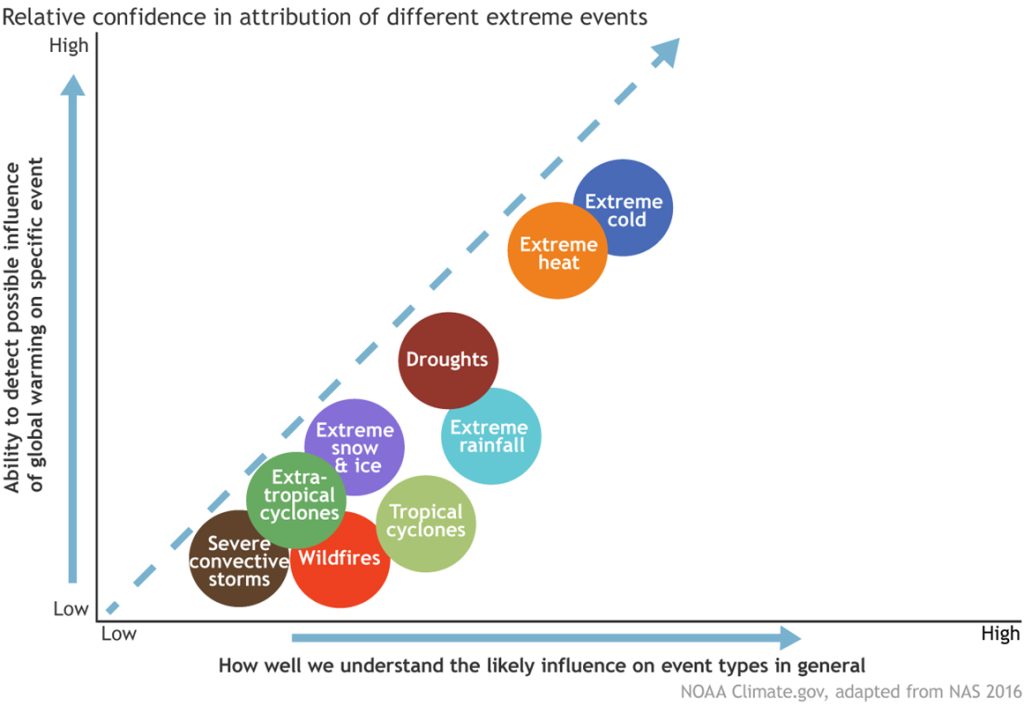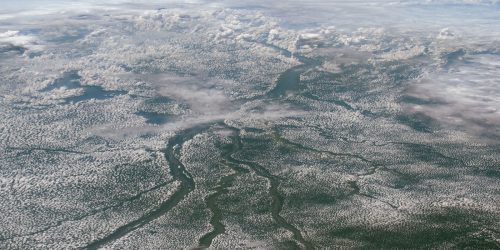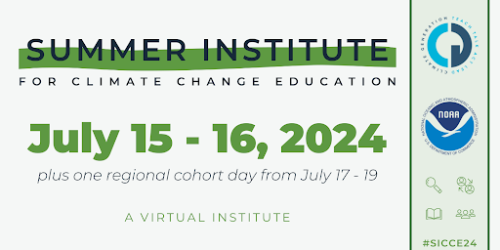NOAA’s Climate Program Office (CPO) is announcing six new three-year projects starting in Fiscal Year 2020 (FY20) and one new four-year project starting in FY21, through a multi-program collaboration that aims to develop a capability to explain the causes of and mechanisms driving extreme events. Specifically, the projects will focus on developing and examining long-term observational records; testing and applying models’ ability to simulate low-frequency, high-impact events; improving understanding of the mechanisms that control and allow for predictability of extreme events in the ways those high- and low-frequency phenomena interact; and improving communication of the risks ,drivers, and predictability of extreme events to stakeholders and communities to build resilience. The competitively selected projects total $6,440,313, including $2,614,070 in grants and $3,826,243 in other awards.

Extreme events in the climate system have a profound effect on the safety of the American public and the security and productivity of the American economy. Together, these events create an annual cost burden of hundreds of billions of dollars for the U.S. economy. The ability to better predict, project, and prepare for these events is a growing field that requires improved understanding, observation, and modeling of their causes.
Current CPO and predecessor research programs have invested for decades in research to understand interactions between the climate system and extremes, dataset development to capture longer and fuller records of climate variability and change, evaluations of the ability of models to simulate extremes, and work to explain how climate variability and change impacts the occurrence and behavior of extreme events. This research is critical to efforts to prepare communities for extreme events and build resilience. To harvest the outcomes of these research efforts, in FY20 CPO solicited proposals to explore and develop the science of explaining climate extreme events, and to develop and test an experimental capability to rapidly assess and explain extreme events.
A number of CPO programs are collaborating to support the research and development activities around this topic of explaining extreme events. The programs include:
- Climate Variability and Predictability (CVP)
- Climate Observations and Monitoring (COM)
- Modeling, Analysis, Predictions, and Projections (MAPP)
- Assessments (AP)
- Developing a process-based understanding of marine heat waves: present and future
While heat waves on land have been studied extensively, research into extremes in the ocean impacting marine life, such as fisheries, is relatively new. This project will utilize new analyses, three-dimensional datasets, and multiple climate model simulations to develop a better understanding of extreme warm events in the ocean. Results will advance our understanding of how these extreme events may change in the future.- Lead Investigator: Michael Alexander, NOAA Physical Sciences Laboratory
- Co-Investigators: Clara Deser, National Center for Atmospheric Research; Michael Jacox, NOAA Southwest Fisheries Science Center
- Collaborators: Adam Phillips, National Center for Atmospheric Research
- Pulsing mass circulation: A new anchor point for understanding and attributing the variability and trends of U.S. extreme cold air outbreaks in a warming climate
Cold air outbreaks in the cool season pose great threats to human life and have profound economic and societal consequences. This project will examine the links between variability and trends of cold air outbreaks to anomalies associated with external radiative forcing, internal modes of variability, and climate feedback processes. Results will advance the analysis and attribution of extreme events.- Lead Investigator: Ming Cai, Florida State University
- Co-Investigator: Yi Deng, Georgia Institute of Technology
- Development of a rapid response capability to evaluate causes of extreme climate events
As the climate continues to warm, the risks associated with climate extremes assume even greater importance. Since 1980, more than 250 extreme events have led to the loss of thousands of lives and damages exceeding $1 billion. This project will investigate extreme event risks and causes in a changing climate. Results from this project will serve as a foundation for NOAA to provide timely information regarding the role of various forcings in causing extreme events.- Lead Investigator: David Easterling, NOAA/National Centers for Environmental
- Co-Investigators: Derek S. Arndt, NOAA National Centers for Environmental; Thomas L. Delworth, NOAA Geophysical Fluid Dynamics Laboratory; Martin P. Hoerling, NOAA Physical Sciences Laboratory; Sarah B. Kapnick, NOAA Geophysical Fluid Dynamics Laboratory; Arun Kumar, NOAA National Centers for Environmental; Russell S. Vose, NOAA National Centers for Environmental; Joseph Barsugli, CIRES, Univ. of Colorado Boulder and NOAA/ESRL; Carl J. Schreck, CISESS, NC State University, and NOAA NCEI
- Changes in the mean state of the tropical Pacific and the mechanism of extreme El Niño events
Extreme El Niño events over the last four decades have led to billions of damages worldwide. This project will examine mechanisms leading to the development of extreme El Niño events. Results have the potential to improve our ability to predict El Niño and anticipate changes in the occurrence of extreme El Niño events and their damaging impacts.- Lead Investigator: Alexey Fedorov, Yale University
- Assessing the influence of lower stratospheric dynamics on North American winter extreme events
Polar vortex events have been responsible for thousands of flight cancellations, ground transportation disruptions, record-breaking gas prices, as well as dozens of fatalities. This project will examine the factors that contribute to these extreme events to better assess their likelihood of occurrence and ultimately provide more accurate information for the future.- Lead Investigator: Andrea Lang, University at Albany
- Anticipatory assessment: Future U.S. droughts under the influence of evolving modes of variability and long-term change
While we do not know exactly which climate conditions will drive the United States into a future drought, we do know that a future extreme drought will occur. This project will enable a real-time assessment of causes and mechanisms of extreme hydroclimate events over the United States. Results will improve drought intelligence, guide adaptation measures, and potentially show how droughts of the future will differ from those of the past.- Lead Investigator: Richard Seager, Columbia University, Lamont-Doherty Earth Observatory
- Toward a rapid assessment capability for dry and oppressive excessive heat events over the United States
Excessive heat results in more fatalities than any other extreme event. This project will examine the influence of climate change and natural climate variability on the occurrence of extreme heat events. Results have potential to improve understanding and uncertainties associated with climate-driven extreme heat events.- Lead Investigator: Augustin Vintzileos, University of Maryland









